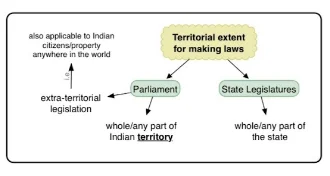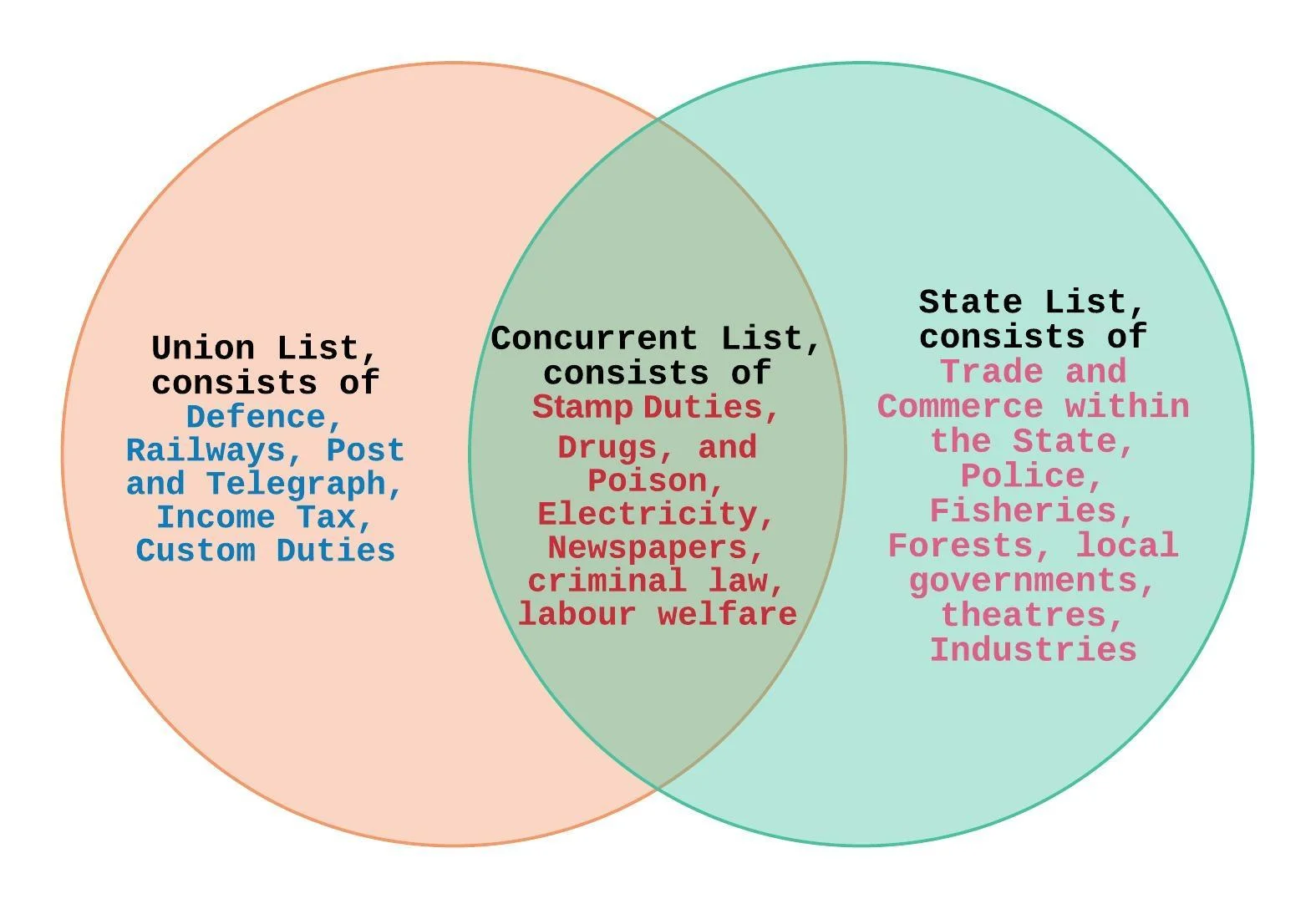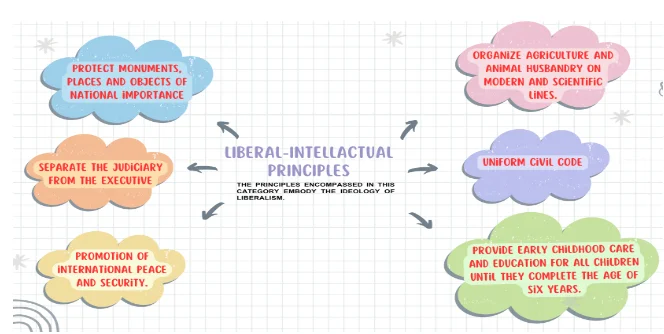The Indian Constitution establishes a detailed framework for legislative relations between the Centre and States, as outlined in Part XI. This division includes a three-tiered distribution of powers and various mechanisms for resolving conflicts. The Constitution’s design ensures a balance between national coherence and state autonomy while addressing exceptional situations that may arise.
Legislative Relations Between Centre and States in India: A Detailed Overview
Framework of Centre-State Legislative Relations in the Indian Constitution
-
- Part XI of the Indian Constitution: It deals with legislative relations between the Centre and States, comprising Articles 245 to 255.
- In addition, there are a few other articles dealing with the same subject.
- Division of Legislative Powers: The Indian Constitution divides the legislative powers between the Centre and the States, both in terms of territory and subjects of legislation.
- Additionally, the Constitution provides for Parliamentary legislation in the State sphere under five extraordinary circumstances, as well as parliament control over State legislation in certain cases.
- Part XI of the Indian Constitution: It deals with legislative relations between the Centre and States, comprising Articles 245 to 255.

- Aspects of Centre-State Legislative Relations: Centre-State legislative relations can be divided into four aspects:
-
- Territorial extent of Central and State legislation (Article 245)
- Distribution of legislative subjects (Article 246)
- Parliamentary legislation in the State field (Articles 249 and 250)
- Central government control over State legislation (Articles 251, 252, 253, 254, and 256)
Enroll now for UPSC Online Course
Territorial Extent Of Central And State Legislation
- Article 245: Extent of laws made by Parliament and by the Legislatures of States
- Territorial Limits of Legislative Powers: The Indian Constitution defines the territorial limits of legislative powers vested in the Parliament and the State legislature as follows:
- Centre’s Legislative Powers: The Parliament can make laws for the whole or any part of the territory of India, which includes the States, the Union Territories, and any other area that is currently a part of India.

- States’ Legislative Powers: A State legislature can make laws for the whole or any part of the State.
- However, State laws are not applicable outside the State unless there is a close connection between the State and the purpose of the law.
- Extraterritorial Legislation: Only the Parliament can make extra-territorial laws, which apply to Indian citizens and their property anywhere in the world.
- Restrictions on Centre’s Plenary Territorial Jurisdiction: However, the Indian Constitution restricts the Centre’s plenary territorial jurisdiction. In other words, the laws of the Parliament do not apply in the following areas:
- President’s Regulations in Union Territories (Article 240)
- The President can make regulations for the peace, progress, and good government of the five union territories i.e., Andaman and Nicobar Islands, Lakshadweep, Dadra and Nagar Haveli, Daman and Diu, and Ladakh.
- A regulation made by the President has the same force and effect as an act of Parliament.
- It can also repeal or amend any act of Parliament in relation to these union territories.
- Governor’s Authority in Scheduled and Tribal Areas (Fifth and Sixth Schedule)
- The Governor is empowered to direct that an act of Parliament does not apply to a scheduled area in the State, or apply with specified modifications and exceptions.
- The Governor of Assam may likewise direct that an act of Parliament does not apply to a tribal area (autonomous district) in the State, or apply with specified modifications and exceptions.
- President’s Power in Tribal Areas of Other States (Sixth Schedule)
- The President has the same power with respect to tribal areas (autonomous districts) in Meghalaya, Tripura, and Mizoram.
Distribution Of Legislative Subjects
Article 246: Subject matter of laws made by Parliament and by the Legislatures of States
- Three-Fold Distribution of Legislative Subjects: The Seventh Schedule of the Indian Constitution provides for a three-fold distribution of legislative subjects between the Centre and the States:
- Union List: The Parliament has exclusive power to make laws on the subjects enumerated in the Union List. This list currently has 100 subjects (originally 97), including defence, banking, foreign affairs, currency, atomic energy, insurance, communication, interState trade and commerce, census, and audit.
- State List: The State governments have exclusive power to make laws on the subjects enumerated in the State List.
- This list currently has 59 subjects (originally 66), including public order, police, public health and sanitation, agriculture, prisons, local government, fisheries, markets, theatres, and gambling.
- Concurrent List: Both the Centre and the States can make laws on the subjects enumerated in the Concurrent List.
- This list currently has 52 subjects (originally 47), including criminal law and procedure, civil procedure, marriage and divorce, population control and family planning, electricity, labour welfare, economic and social planning, drugs, newspapers, books, and printing press.
-
- Subjects Transferred from State List to Concurrent List: The 42nd Amendment of the Indian Constitution, enacted in 1976, brought about a significant change in the division of legislative powers between the Centre and the States.
- It transferred five subjects from the State List to the Concurrent List, which means that both the Central and State governments can now legislate on these matters. These subjects are:
- Education
- Forests
- Weights and Measures
- Protection of Wild Animals and Birds
- Administration of Justice, including the constitution and organisation of all courts except the Supreme Court and the high courts
- It transferred five subjects from the State List to the Concurrent List, which means that both the Central and State governments can now legislate on these matters. These subjects are:
- Subjects Transferred from State List to Concurrent List: The 42nd Amendment of the Indian Constitution, enacted in 1976, brought about a significant change in the division of legislative powers between the Centre and the States.
- Additional Provisions: In addition to the above, the following provisions apply:
-
- Legislative Power Over Non-State Territories: The Centre has power to make laws with respect to any matter for any part of the territory of India that is not included in a State, even if that matter is enumerated in the State List.
- This provision applies to the Union Territories and any acquired territories.
- Goods and Services Tax (GST) Provisions: The 101st Amendment Act of 2016 made a special provision for Goods and Services tax (GST).
- Accordingly, both the Parliament and the State Legislatures have power to make laws with respect to GST imposed by the Union or by the State.
- However, the Parliament has exclusive power to make laws with respect to GST where the supply of goods or services, or both, takes place in the course of Interstate trade or commerce.
- Legislative Power Over Non-State Territories: The Centre has power to make laws with respect to any matter for any part of the territory of India that is not included in a State, even if that matter is enumerated in the State List.

Article 248: Residuary powers of legislation
- Parliament has exclusive power to make any law with respect to any matter not enumerated in the Concurrent List or State List
- Such power shall include the power of making any law imposing a tax not mentioned in either of those Lists
Article 254: Inconsistency between laws made by Parliament and laws made by the State Legislatures
- Supremacy of Legislative Lists: The Constitution establishes the supremacy of the Union List over both the State List and the Concurrent List, and the supremacy of the Concurrent List over the State List.
- Union List Prevails:In the event of overlapping legislative subjects between the Union List and the State List, the Union List prevails.
- Union List Takes Precedence: In the case of overlapping subjects between the Union List and the Concurrent List, the Union List takes precedence.
- Concurrent List Prevails: Finally, if there is a conflict between the Concurrent List and the State List, the Concurrent List prevails.
- Conflict Between Central and State Laws:
- Central Law Precedence: In the event of a conflict between a Central law and a State law on a subject enumerated in the Concurrent List, the Central law takes precedence over the State law. However, there is an exception.
- Exception: If the State law has been reserved for the consideration of the President and has received his assent, then the State law prevails in that State.
- However, the Parliament still has the authority to override such a law by subsequently making a law on the same matter.
Comparative Analysis
Table given below outlines the different systems of legislative powers and their implications in India, the United States, Australia, and Canada.
| Country | Legislative Lists | Description |
| India | Union List |
|
| State List |
|
|
| Concurrent List |
|
|
| United States | Federal Powers |
|
| Australia | Federal Powers |
|
| Canada | Federal Powers |
|
| Provincial Powers |
|
- Three-Tiered Distribution of Legislative Powers (1935 Act): The Government of India Act of 1935 introduced a three-tiered distribution of legislative powers: federal, provincial, and concurrent.
- Current Constitutional Structure: The current Constitution upholds this structure, with one distinction: under the previous Act, residual powers were vested in neither federal nor provincial legislatures but in the Governor-General of India.
- In this respect, India follows the Canadian precedent.
- Articles Related to Centre-State Legislative Relations:
| Article Number | Subject Matter |
| 245 | Extent of laws made by Parliament and by the Legislatures of States |
| 246 | Subject Matter of Laws Made by Parliament and by the Legislatures of States |
| 246A | Special provision with respect to Goods and Services Tax |
| 247 | Power of Parliament to provide for the establishment of certain additional courts |
| 248 | Residuary Powers of Legislation |
| 249 | Power of Parliament to legislate with respect to a matter in the State List in the national interest |
| 250 | Power of Parliament to legislate with respect to any matter in the State List if a Proclamation of Emergency is in operation |
| 251 | Inconsistency between laws made by Parliament under Articles 249 and 250 and laws made by the Legislatures of States |
| 252 | Power of Parliament to legislate for two or more States by consent and adoption of such legislation by any other State |
| 253 | Legislation for giving effect to international agreements |
| 254 | Inconsistency between laws made by Parliament and laws made by the legislatures of States |
| 255 | Requirements as to recommendations and previous sanctions to be regarded as matters of procedure only |

Enroll now for UPSC Online Course
| Must Read | |
| Current Affairs | Editorial Analysis |
| Upsc Notes | Upsc Blogs |
| NCERT Notes | Free Main Answer Writing |
Conclusion
The Indian system of Centre-State legislative relations is crafted to maintain national unity while respecting regional diversity.
- By defining powers across Union, State, and Concurrent Lists, and providing for exceptional legislative measures, the Constitution aims to harmonize governance and address the complex needs of a diverse nation.
Sign up for the PWOnlyIAS Online Course by Physics Wallah and start your journey to IAS success today!
| Related Articles | |
| The Government of India Act, 1935 | Indian Constitution Schedules |
| Indian Constitution | State Legislature in India |

 GS Foundation
GS Foundation Optional Course
Optional Course Combo Courses
Combo Courses Degree Program
Degree Program









